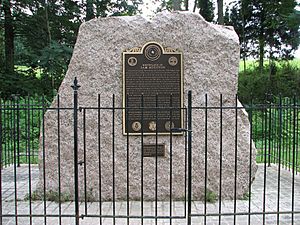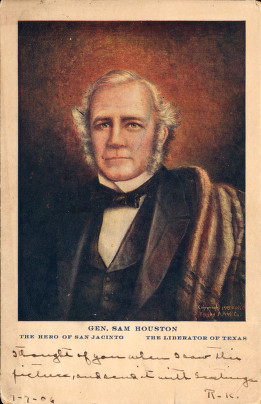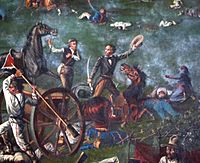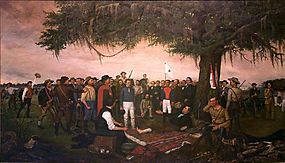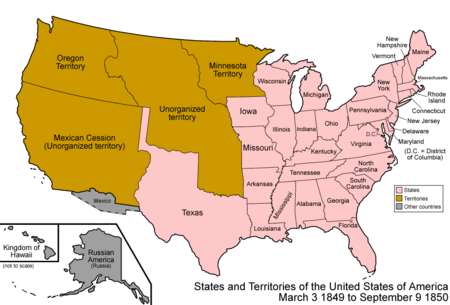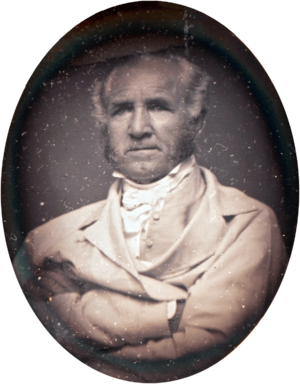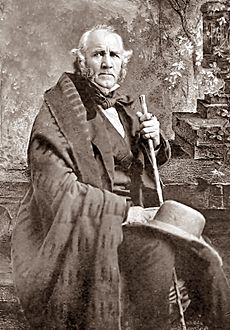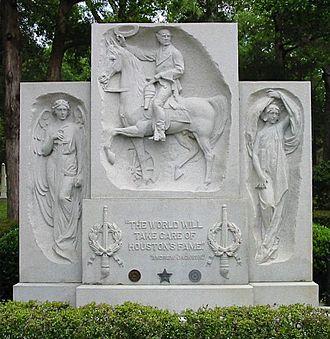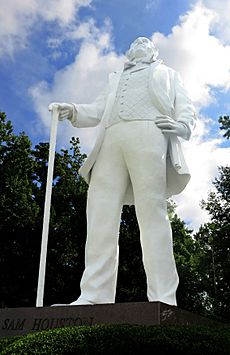Sam Houston facts for kids
Quick facts for kids
Sam Houston
|
|
|---|---|
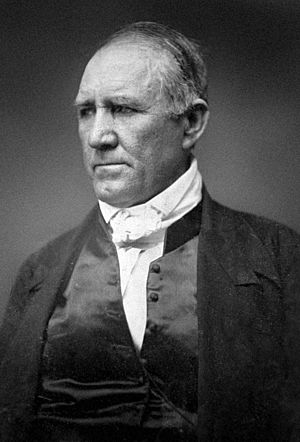 |
|
| 7th Governor of Texas | |
| In office December 21, 1859 – March 15, 1861 |
|
| Lieutenant | Edward Clark |
| Preceded by | Hardin Richard Runnels |
| Succeeded by | Edward Clark |
| United States Senator from Texas |
|
| In office February 21, 1846 – March 3, 1859 |
|
| Preceded by | Seat established |
| Succeeded by | John Hemphill |
| 1st and 3rd President of Texas | |
| In office December 21, 1841 – December 9, 1844 |
|
| Vice President | Edward Burleson |
| Preceded by | Mirabeau B. Lamar |
| Succeeded by | Anson Jones |
| In office October 22, 1836 – December 10, 1838 |
|
| Vice President | Mirabeau B. Lamar |
| Preceded by | David G. Burnet (acting) |
| Succeeded by | Mirabeau B. Lamar |
| Member of the Texas House of Representatives from the San Augustine district |
|
| In office 1839–1841 |
|
| 6th Governor of Tennessee | |
| In office October 1, 1827 – April 16, 1829 |
|
| Lieutenant | William Hall |
| Preceded by | William Carroll |
| Succeeded by | William Hall |
| Member of the U.S. House of Representatives from Tennessee's 7th district |
|
| In office March 4, 1823 – March 3, 1827 |
|
| Preceded by | Constituency established |
| Succeeded by | John Bell |
| Personal details | |
| Born |
Samuel Houston
March 2, 1793 Rockbridge, Virginia, U.S. |
| Died | July 26, 1863 (aged 70) Huntsville, Texas, C.S. |
| Political party | Democratic-Republican (before 1830) Democratic (1846–1854) Know Nothing (1855–1856) Independent (1856–1863) |
| Spouses |
Eliza Allen
(m. 1829; div. 1837)Tiana Rogers
(m. 1830; annulled 1832)Margaret Lea
(m. 1840) |
| Education | Maryville College |
| Signature | |
| Military service | |
| Allegiance | |
| Branch/service | United States Army Texan Army |
| Years of service | 1813–1818 (U.S. Army) 1835–1836 (Texan Army) |
| Rank | Major General (Texan Army) |
| Unit | 39th Infantry Regiment (U.S. Army) |
| Commands | Army of the Republic of Texas (Texan Army) |
| Battles/wars | War of 1812 Creek War • Battle of Horseshoe Bend Texas Revolution • Battle of San Jacinto |
Samuel Houston (![]() i/ˈhjuːstən/, HEW-stən; March 2, 1793 – July 26, 1863) was an American general and important leader in the Texas Revolution. He was the first and third president of the Republic of Texas. He also served as one of the first two senators for Texas in the United States Senate. Before that, he was the sixth governor of Tennessee and later the seventh governor of Texas. He is the only person to be elected governor of two different U.S. states.
i/ˈhjuːstən/, HEW-stən; March 2, 1793 – July 26, 1863) was an American general and important leader in the Texas Revolution. He was the first and third president of the Republic of Texas. He also served as one of the first two senators for Texas in the United States Senate. Before that, he was the sixth governor of Tennessee and later the seventh governor of Texas. He is the only person to be elected governor of two different U.S. states.
Born in Rockbridge County, Virginia, Houston moved with his family to Maryville, Tennessee, as a teenager. He later lived with the Cherokee tribe for about three years, where he was known as Raven. He fought in the War of 1812 under General Andrew Jackson. After the war, he helped with the relocation of many Cherokee people from Tennessee. With support from Jackson, Houston was elected to the United States House of Representatives in 1823. He became governor of Tennessee in 1827. In 1829, he resigned from office and moved to Arkansas Territory.
Houston settled in Texas in 1832. After the Battle of Gonzales, he helped create Texas's temporary government. He was chosen as the top leader of the Texian Army. He led the Texan Army to a big victory at the Battle of San Jacinto. This battle was key to Texas winning independence from Mexico. After the war, Houston was elected president of Texas in 1836. He left office in 1838 due to term limits but was elected again in 1841. Houston played a major role in Texas joining the United States in 1845. In 1846, he was elected to represent Texas in the U.S. Senate. He joined the Democratic Party and supported President James K. Polk during the Mexican–American War.
In the Senate, Houston was known for wanting to keep the United States together. He opposed extreme views from both the North and South. He voted for the Compromise of 1850, which helped solve land issues after the Mexican–American War. He later voted against the Kansas–Nebraska Act. He believed this act would cause more arguments about slavery. His opposition led him to leave the Democratic Party. He tried to become president in 1856 and 1860 but was not successful. In 1859, Houston became governor of Texas. In this role, he was against Texas leaving the Union. He tried to keep Texas out of the Confederate States of America. He was forced out of office in 1861 and died in 1863. Many places are named after Houston, including the city of Houston, which is the fourth largest city in the U.S.
Contents
Early Life and Cherokee Connections
Samuel Houston was born in Rockbridge County, Virginia, on March 2, 1793. His parents were Samuel Houston and Elizabeth Paxton. His family had Scottish and Irish roots. They came to Colonial America in the 1730s. His father, Captain Houston, served in the American Revolutionary War.
In 1806, Samuel's father died. His mother, Elizabeth, moved the family west to Maryville, Tennessee. This area was then the American frontier. It was a wild place, and towns had to be careful about Native American raids. Elizabeth worked hard to build a home and farm.
When he was 16, Samuel left his family. He went to live with a Cherokee tribe led by Chief John Jolly on Hiwassee Island. Houston learned the Cherokee language and was called Raven. He enjoyed the spiritual freedom of the Native Americans. In 1812, he returned to Maryville. At 19, he worked as a schoolmaster. He also attended Porter Academy.
Military Service and Early Politics
Fighting in the War of 1812
In 1812, Houston joined the United States Army. The U.S. was fighting Britain and its Native American allies in the War of 1812. Houston quickly impressed his commander, Thomas Hart Benton. By late 1813, he was a third lieutenant. In 1814, his regiment joined General Andrew Jackson's forces. Jackson was fighting a group of the Muscogee (or "Creek") tribe.
Houston was badly hurt in the Battle of Horseshoe Bend. This was a key battle in the Creek War. Doctors thought he might die, but he recovered. After the war, Houston kept his military position. He was promoted to second lieutenant.
Working with the Cherokee
In 1817, Houston worked in Nashville for the army. Later, Jackson made him an agent to help move Cherokee people from East Tennessee. In 1818, Houston resigned from the army. He continued to work with the Cherokee. He helped some Cherokee people move to Arkansas Territory.
Starting a Political Career
After leaving the army, Houston became a lawyer in Lebanon, Tennessee. He quickly became the district attorney for Nashville in 1819. He was also made a major general in the Tennessee militia. Houston was part of the Democratic-Republican Party.
In 1823, Houston was elected to the United States House of Representatives. He had support from Jackson. In Congress, he spoke out for Greece, which was fighting for independence. Houston strongly supported Jackson for president in 1824. Jackson's supporters later formed the Democratic Party. With Jackson's help, Houston was elected governor of Tennessee in 1827. As governor, he supported building canals and lowering land prices. He also helped Jackson win the 1828 presidential election.
In 1829, Houston married Eliza Allen. Their marriage ended quickly. After this, Houston resigned as governor. He then went to live with the Cherokee again in Arkansas Territory.
Leading the Texas Revolution
In 1832, friends convinced Houston to move to Texas. There was growing unrest among American settlers. The Mexican government had invited Americans to settle Texas. But many settlers did not like Mexican rule. Houston arrived in Texas in December 1832. He was given land there.
Houston was chosen to represent Nacogdoches at the Convention of 1833. This meeting asked Mexico to make Texas a state. Houston supported this idea. He helped write a proposed state constitution. Later, Mexican President Antonio López de Santa Anna took more power and arrested Texan leader Stephen F. Austin.
In October 1835, the Texas Revolution began with the Battle of Gonzales. Houston was elected to the Consultation, a group of Texas leaders. He helped organize a temporary government for Texas. He was appointed a major general and the highest-ranking officer of the Texian Army.
The Alamo and Retreat
Houston helped organize the Convention of 1836. Here, the Republic of Texas declared independence from Mexico. Houston was made Commander-in-Chief of the Texas Army. Soon after, they heard that William B. Travis and his forces were under siege at the Alamo. Houston was sent to help, but the Alamo fell before he could get there. The Mexican army killed all the defenders at the Alamo. This news angered Texans and caused some soldiers to leave Houston's army.
Houston had about 350 men, far fewer than Santa Anna's army. He decided to retreat east across the Colorado River. Many people wanted him to attack, but Houston knew his small army was Texas's only hope. He told his soldiers, "There are but a few of us, and if we are beaten, the fate of Texas is sealed."
Victory at San Jacinto
Santa Anna divided his forces and finally caught up to Houston in mid-April 1836. Santa Anna's army of about 1,350 soldiers trapped Houston's 783 men in a marsh. Instead of attacking, Santa Anna ordered his soldiers to set up camp. On April 21, Houston ordered an attack on the Mexican army. This started the Battle of San Jacinto.
The Texans quickly defeated Santa Anna's forces. Houston's horse was shot, and his ankle was broken by a bullet. After the battle, Texans captured Santa Anna. He was forced to sign the Treaty of Velasco, which gave Texas its independence. Houston then went to the United States to get treatment for his ankle.
President of the Republic of Texas
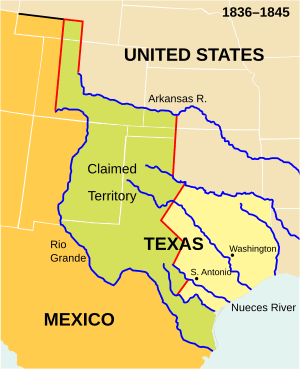
Houston became a hero after the Battle of San Jacinto. He won the 1836 Republic of Texas presidential election. He defeated Stephen F. Austin. Houston took office on October 22, 1836. Most Texans wanted Texas to join the United States. Houston faced challenges like setting up a new government and managing money. He also had to deal with Mexico.
U.S. President Andrew Jackson did not push for Texas to join the U.S. He was worried about upsetting the balance between states that allowed slavery and those that didn't. But Jackson did officially recognize Texas as an independent country. Since the U.S. wouldn't annex Texas, Houston sought support from Britain. He even urged an end to importing slaves into Texas to gain British favor.
In early 1837, the government moved to a new capital, the city of Houston, named after him. In 1838, Houston had disagreements with Congress. He also had to stop the Córdova Rebellion, a plot to help Mexico reclaim Texas. The Texas constitution did not allow presidents to serve two terms in a row. So, Houston did not run for re-election in 1838. He was replaced by Mirabeau B. Lamar. Lamar was part of a group of politicians who opposed Houston. Lamar's government removed many of Houston's people. It also started a war against the Cherokee and set up a new capital in Austin.
Houston opened a law practice and started a land company. In 1839, he was elected to the Texas House of Representatives.
Second Term as President
Houston defeated Burnet in the 1841 Republic of Texas presidential election. He won by a large margin. The republic faced money problems. Houston even took control of an American ship used for soldiers because the government couldn't pay for it. Lamar's actions had caused tension with Mexico. There were often rumors that Santa Anna would invade Texas.
Houston continued to seek support from Britain and France. He hoped their interest in Texas would encourage the United States to annex Texas. The Tyler administration in the U.S. made annexing Texas a top goal. In April 1844, Texas and the U.S. signed an annexation treaty. However, the U.S. Senate rejected the treaty.
In the 1844 U.S. presidential election, James K. Polk won. Polk was a friend of Houston and supported annexing Texas. Houston's term ended in December 1844. He was replaced by Anson Jones. President Tyler used Polk's victory to convince Congress to approve the annexation of Texas. Texas accepted the offer in July 1845. Texas officially became the 28th U.S. state on December 29, 1845.
United States Senator
Mexican–American War and Slavery Debates
In February 1846, the Texas legislature elected Houston and Thomas Jefferson Rusk as Texas's first two U.S. senators. Houston joined the Democratic Party. He was the only former foreign head of state to serve in the U.S. Congress. He was also the first person to be a state governor and then a U.S. Senator for a different state.
In 1846, Houston strongly supported the annexation of Oregon Country. Later that year, Britain and the U.S. agreed to divide Oregon Country. Meanwhile, the Mexican–American War began in April 1846. This happened after U.S. General Zachary Taylor moved troops to the Rio Grande. Mexico claimed the Nueces River was the border. Houston first supported the war. After two years, the U.S. defeated Mexico. Through the Treaty of Guadalupe Hidalgo, the U.S. gained new lands. Mexico also recognized the Rio Grande as the border with Texas.
After the war, arguments grew about whether slavery should spread into new territories. Unlike most Southern senators, Houston voted for the Oregon Bill of 1848. This bill made Oregon a free territory, meaning slavery was not allowed there. Houston said he did not want to harm the South, but he did not think they should always argue about slavery. He criticized both Northern abolitionists and Southern Democrats as extremists. He supported the Compromise of 1850. This compromise tried to settle the slavery debate in the territories. California became a free state. The slave trade was banned in Washington D.C. A stricter law about runaway slaves was passed. New territories like Utah and New Mexico were created. Texas gave up some land claims in New Mexico but kept El Paso. The U.S. also took on Texas's large public debt.
Houston tried to get the Democratic nomination for president in 1852. But he could not get enough support outside Texas. Franklin Pierce won the nomination and the election.
Later Senate Years and Governor of Texas
In 1854, Senator Stephen A. Douglas helped pass the Kansas–Nebraska Act. This act organized Kansas and Nebraska territories. It also ended the Missouri Compromise, which had banned slavery in northern territories. Houston voted against this act. He believed it would cause more tension over slavery. His opposition led him to leave the Democratic Party.
In 1855, Houston became linked with the American Party, also known as the Know Nothing movement. This party was against immigrants and wanted to keep the country united. Houston liked their support for a Native American state and their unionist stance. He tried to get the Know Nothing party's presidential nomination in 1856. But they chose Millard Fillmore. Houston was disappointed but supported Fillmore. The American Party later split over slavery. James Buchanan won the 1856 election.
After the election, the American Party fell apart. Houston did not join another national party. In 1857, Texas Democrats nominated Hardin Richard Runnels for governor. Runnels supported the Kansas–Nebraska Act and criticized Houston. Houston ran for governor himself but lost to Runnels. This was his only election loss. After this, the Texas legislature did not re-elect Houston to the Senate. He served until his term ended in early 1859.
Governor of Texas and the Civil War
Houston ran against Runnels again in the 1859 Texas gubernatorial election. He won this time, becoming governor in December 1859. In the 1860 presidential election, Houston was a possible candidate for the Constitutional Union Party. This party was made up of Southerners who wanted to keep the Union together. John Bell won the nomination. Some Texans still nominated Houston for president, but he announced he would not run. He refused to support any other candidate. In late 1860, Houston traveled Texas. He urged Texans to resist those who wanted to leave the Union if Abraham Lincoln won the election.
After Lincoln won in November 1860, several Southern states left the United States. They formed the Confederate States of America. A Texas convention voted to secede on February 1, 1861. Houston said Texas was an independent republic again. But he refused to recognize the convention's power to join Texas to the Confederacy. Houston refused to swear loyalty to the Confederacy. So, the legislature declared his governorship empty. Houston did not agree with his removal. But he did not use force to stay in office. He also refused help from the federal government to prevent his removal. His replacement, Edward Clark, became governor on March 18.
Historian Randolph Campbell said: "Houston did everything possible to prevent secession and war. But his first loyalty was to Texas—and the South. Houston refused offers of troops from the United States to keep Texas in the Union. He announced on May 10, 1861, that he would stand with the Confederacy in its war effort."
Retirement and Passing
After leaving office, Houston went home to Galveston. He later moved to Huntsville, Texas. He lived in a house called the Steamboat House. During the Civil War, many Texas leaders avoided Houston. But he still wrote to Confederate officer Ashbel Smith and Texas governor Francis Lubbock. His son, Sam Houston, Jr., fought in the Confederate army. He came home after being wounded at the Battle of Shiloh. Houston's health got much worse in April 1863. He passed away on July 26, 1863, at 70 years old.
The words on Houston's tomb say:
A Brave Soldier. A Fearless Statesman.
A Great Orator—A Pure Patriot.
A Faithful Friend, A Loyal Citizen.
A Devoted Husband and Father.
A Consistent Christian—An Honest Man.
Personal Life and Family
In January 1829, Houston married 19-year-old Eliza Allen. The marriage lasted only 11 weeks. Neither Houston nor Eliza ever said why they separated. Eliza did not agree to a divorce at first. Houston then resigned as governor and lived with his Cherokee family for three years. In 1830, Houston married Tiana Rogers in a Cherokee ceremony. Tiana was the daughter of Chief John "Hellfire" Rogers. She had two children from a previous marriage. Tiana and Houston lived together for several years. Tennessee society did not approve because Houston was still legally married to Eliza Allen. Tiana later remarried after Houston moved to Texas. She died in 1838.
In 1837, after becoming President of Texas, Houston was able to get a divorce from Eliza Allen.
On May 9, 1840, Houston, at 47, married for a third time. His bride was 21-year-old Margaret Moffette Lea. She was the daughter of planters from Alabama. They had eight children together. Margaret had a calming effect on Houston. She convinced him to stop drinking. The Houstons had many homes. They continuously kept one called Cedar Point on Trinity Bay.
In 1833, Houston was baptized into the Catholic faith. This was required by Mexican law to own property in Coahuila y Tejas. By 1854, Margaret had tried for 14 years to convert Houston to the Baptist church. With help from George Washington Baines, she succeeded. Houston agreed to be baptized as an adult. Many people came to Independence, Texas, to see it. On November 19, 1854, Houston was baptized by Rev. Rufus Columbus Burleson in Little Rocky Creek.
Views on Slavery
Houston was born on a slave plantation and inherited slaves. He owned many slaves throughout his life. While he did not enforce some anti-slavery rules, strong slavery laws were still in place under his leadership. He did not support slavery expanding westward. Houston owned slaves but held a "centrist" view. He believed both sides of the slavery debate were too extreme. His main goal was to keep the Union from splitting apart. He thought states should decide for themselves about slavery.
Legacy and Honors
Houston, the largest city in Texas, is named after him. Many other places are named for Houston, including:
- Sam Houston State University
- Houston County, Minnesota
- Houston County, Tennessee
- Houston County, Texas
Other memorials include:
- Sam Houston National Forest
- Sam Houston Regional Library and Research Center
- U.S. Army post Fort Sam Houston in San Antonio
- The USS Sam Houston (SSBN-609)
- A sculpture of Houston in Houston's Hermann Park
A 67-foot-tall statue of Houston, called A Tribute to Courage, stands next to I-45 in Huntsville, Texas. It is often called "Big Sam." Along with Stephen F. Austin, Houston has a statue in the National Statuary Hall in Washington D.C. Houston has been shown in movies like Man of Conquest and The Alamo. In 1960, he was added to the Hall of Great Westerners.
There was a question about whether Houston made a negative comment about Mexicans in an 1835 speech. One old source claimed this, but later research suggests it likely did not happen.
See also
 In Spanish: Samuel Houston para niños
In Spanish: Samuel Houston para niños


